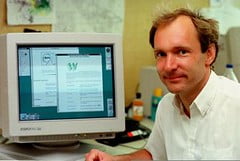- Tim Berners-Lee was born on June 8, 1955 and is the inventor of the World Wide Web.
- His work at CERN led to the creation of HTML, URIs, and HTTP.
- He chose to make the Web free and open source for everyone.
- He founded the W3C in 1994 to develop web standards and promote the evolution of the Web.

Biography of Tim Berners-Lee
The Birth of the World Wide Web
- HTML (HyperText Markup Language): The markup language for creating web pages.
- URI (Uniform Resource Identifier): A unique “name” or “address” for each resource on the Web.
- HTTP (Hypertext Transfer Protocol): Allows the retrieval of linked resources on the Web.
Impact and Legacy
Recognitions and Honors
- Knight Commander of the Order of the British Empire (KBE) in 2004
- Order of Merit of the United Kingdom in 2007
- ACM Turing Award 2016
- Queen Elizabeth Engineering Prize 2013
Vision for the Future of the Web
The Philosophy of Tim Berners-Lee
«The Web is more a social creation than a technical one. I designed it to have a social effect – to help people work together – and not as a technical toy.»
Lessons from Tim Berners-Lee's Biography
- The power of an idea: A single idea, well executed, can change the world.
- The importance of sharingBy making the Web free and open, Berners-Lee enabled its rapid adoption and evolution.
- The responsibility that comes with innovationBerners-Lee didn't stop after inventing the Web, but continues to work to improve and protect it.
- InterdisciplinarityBerners-Lee's background in physics gave him a unique perspective that allowed him to innovate in the field of computer science.
- The long term vision:From the beginning, Berners-Lee saw the potential of the Web to connect people and share knowledge on a global scale.
Tim Berners-Lee FAQ
1. When and where was Tim Berners-Lee born?
2. What is Tim Berners-Lee's most famous invention?
3. Why didn't Tim Berners-Lee get rich from the invention of the Web?
4. What is Tim Berners-Lee doing now?
5. Has Tim Berners-Lee received any major awards for his work?


